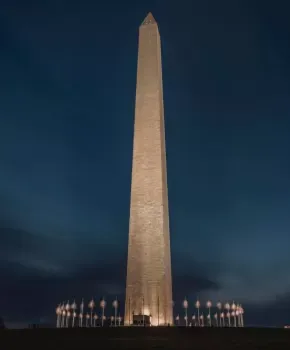Washington D.C., the capital of the United States, is not only the political center but also a treasure trove of history with countless landmarks bearing the imprint of time. From majestic monuments to museums preserving memories, every corner of Washington D.C. tells a story. Let’s explore the must-visit destinations for anyone who loves history and culture.
Washington Monument: A Timeless Symbol
Built to commemorate George Washington, the first president of the United States and commander-in-chief of the Continental Army, the Washington Monument was once the tallest building in the world, standing at over 169 meters (555 feet). To this day, it holds the record as the world’s tallest stone structure and obelisk, a symbol of the resilience and leadership of the founding father.

New Enhancements at the Washington Monument
After years of renovations, the Washington Monument reopened in 2019 with significant upgrades. One of these is a modern elevator system, allowing visitors to ascend to the observation deck quickly and efficiently.
The journey takes just one minute to reach the top of the world’s tallest stone structure, with a short video from the National Park Service showcasing the highlights. From the observation deck, visitors can admire panoramic views of Washington D.C. within a radius of nearly 40 km (25 miles), including famous landmarks such as the U.S. Capitol, the White House, Arlington National Cemetery, and the Washington National Cathedral.
A special feature of the elevator ride is on the descent, where visitors have the opportunity to view the memorial stones dedicated to George Washington, carved by states, organizations, and individuals. The new elevator system allows the National Park Service to have better control, including remote access capabilities.
Before boarding the elevator, visitors pass through an upgraded security checkpoint, capable of accommodating up to 20 people and equipped with modern screening devices.
The Washington Monument is open from 9:00 AM to 5:00 PM daily (last tickets sold at 4:00 PM), except for April 25th, July 3rd, and part of July 4th. Visitors can book tickets in advance through the website recreation.gov. A limited number of tickets are also distributed free of charge on a first-come, first-served basis, starting at 8:45 AM at the Washington Monument Lodge.
Other Useful Information About the Washington Monument
Managed by the National Park Service, the Washington Monument is located in the center of the National Mall, between the U.S. Capitol and the Lincoln Memorial.
To reach the monument, visitors can use the metro. The two nearest stations are Federal Triangle and Smithsonian, both on the Blue, Orange, and Silver lines. By bus, take the DC Circulator’s National Mall route or Metrobus routes 32, 34, or 36. If driving, visitors can park on Ohio Drive, between the Lincoln and Jefferson Memorials. However, be aware that street parking is often limited near the National Mall.
Why Is the Washington Monument Two Colors?
The construction of the Washington Monument faced many difficulties and was prolonged. The original design was by Robert Mills, with construction beginning in 1848. However, the American Civil War, the rise of the Know Nothing Party, and funding shortages caused construction to stall in 1854.
When construction resumed in 1879, the marble used came from a different quarry. Additionally, the erosion of time and weather led to a difference in color, starting at a height of about 45 meters (150 feet).
The monument was finally completed in 1884 by Thomas Casey and the U.S. Army Corps of Engineers, and the elevator was installed in 1889. This color difference does not detract from the beauty and historical significance of the structure, but rather serves as a testament to the difficulties and challenges that America overcame.

U.S. Capitol: The Heart of Democracy
The U.S. Capitol is the seat of the United States Congress, a symbol of democracy and legislative power. Visitors can tour the Senate and House of Representatives chambers, admire the magnificent architecture, and learn about the history of this legislative body.
The White House: Residence and Workplace of the President
The White House is not only the residence of the President of the United States but also the workplace and reception venue for heads of state. Visitors can tour some public areas of the White House, learn about the history and role of the President in the U.S. political system. However, visiting the White House often requires advance booking and adherence to strict security regulations.
Arlington National Cemetery: Resting Place of Heroes
Arlington National Cemetery is the final resting place of hundreds of thousands of U.S. military personnel, from ordinary soldiers to renowned generals. This is a solemn and moving place where visitors can pay their respects to those who sacrificed for their country. The grave of President John F. Kennedy and the Tomb of the Unknown Soldier are particularly popular attractions.
Smithsonian Museums: A Treasure Trove of Priceless Knowledge
Washington D.C. is home to many museums belonging to the Smithsonian Institution, one of the world’s largest museum and research organizations. Smithsonian museums include the National Museum of Natural History, the National Air and Space Museum, the National Museum of American History, and many others. Visitors can explore countless historical, scientific, cultural, and artistic artifacts, from dinosaur fossils to Apollo spacecraft.
Conclusion
Washington D.C. is a historical city with countless places to visit. From majestic monuments to rich museums, each location tells its own story. Hopefully, this guide will help you have an interesting and meaningful trip to the capital of the United States. Are you ready to explore the heroic pages of American history in Washington D.C.?